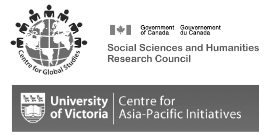Project Director’s Message October 2025
Dear Colleagues,
Some parts of a Project Director’s role are more inherently joyful than others. Drawing team members together around shared ideas and ambitious plans? – that’s pretty good. When I join proud colleagues at the launch of their exhibition, the publication of a book, or the unveiling of a resource, I get to “shep nachas,” a Yiddish phrase that my father-in-law used for the inimitable joy we feel at the accomplishments of loved ones. Perhaps nothing beats watching a student transformed, in the course a few years, from a fresh and anxious kid into a confident young person, speaking with expertise and moving with confidence.
And then there are . . . other parts of the role, like completing the Midterm Progress Report for the Social Sciences and Humanities Research Council of Canada. This is the moment when, at the halfway point of a partnership, the funding agency checks in on us. Ottawa appoints a panel to review our activity, to take stock of our progress toward our aims, and to determine whether we’re on track. To complete the report, a Project Director fills in eight text boxes of 3,000 characters each (spaces included), detailing accomplishments, challenges, substantial changes, and future plans in the areas of research, knowledge mobilization, training, governance, and budget. There are check boxes and tables. Blank, the document runs 12 pages and filled, it’s perhaps twice that length. The task sometimes calls to mind my favourite New Yorker cartoon.
But, I’m finding, as I near the completion of an initial draft for Past Wrongs, Future Choices, that there are joys to be found here too. Our partnership proposed to host six scholars and artists in residence. In the end we managed over 20, each one of them a source of inspiration within an intellectual and creative community that we nurtured. We envisioned three books by the end of the partnership but find ourselves on track to produce six. We said we would support an exhibition on the dispossession of Japanese Canadians to travel to one museum in Japan. Colleagues there transformed that vision into a tour that has gone to seven locations, each supplementing our collective work with local research and content. When we started, we imagined that we would spend our first years building a network and then begin to communicate outward to wider audiences in the second half of the grant. Instead, we’ve collectively given some 200 presentations to audiences of all kinds. Filling in a report may not be inherently joyful, but good colleagues can make it feel pretty sweet – look at all we’ve done!
If you’re a member of the research collective – the lead of a partner organization, a researcher, an artist, a curator, or anyone else actively involved in our work – I’d love to hear from you as I complete the report. I don’t want to miss out on your accomplishments as I compile and contemplate the work of the collective. If you’ve given presentations, published or exhibited work, hosted events, or otherwise engaged in activities that are related to PWFC or inspired by our partnership that you would like us to include in our reports, please let me know (email jstross@uvic.ca). And, please mark your calendars for October 16/17 when we’ll have a project wide meeting and October 17/18 when the Integration and Governance Boards will meet. These will be opportunities to review the report, consider what we have accomplished to date, and to make future plans. We’re at a crucial juncture in our partnership at which we need your input.
And to friends and allies outside the research collective who read our newsletter, please take heart, along with me, in knowing that this partnership is very much on track.


 Instagram
Instagram